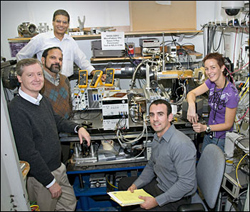Physics professor collaborates on NASA project selected for space mission
|
NASA has announced that a project to measure the polarization of x-rays from black holes, in which physics professor C. J. Martoff is a collaborator, has been selected for a flight mission. The $105 million project, Gravity and Extreme Magnetism Small Explorer (GEMS), is being developed by a group at NASA’s Goddard Space Flight Center and will be launched into space as part of NASA’s Small Explorer Program sometime between 2012-15. According to Nicholas E. White, director of the Sciences and Exploration Directorate at Goddard, the mission “will probe the space-time environment close to black holes, to test general relativity in this extreme environment and study the most intense magnetic fields found in the universe… It will do this by opening up a whole new field of x-ray polarization studies, using new technology developed here at GSFC.” |
 Courtesy Brookhaven National Laboratory
Temple Physics Professor C. J. Martoff (second from left) and his doctoral student Michael Dion (seated) work with members of the Goddard Space Flight Center Team at Brookhaven National Laboratory last fall. Also pictured are (from left) Kevin Black, Syed Khalid, and Joe Hill.
|
|
Martoff spent six months as an Oak Ridge Associated Universities Senior Fellow, working with the Goddard team last fall on an Oak Ridge Associated Universities Senior Fellowship. He was joined by his doctoral student, Michael Dion. Martoff had previously developed a direction-sensitive dark matter detector called DRIFT, which uses a negative ion drift technique instead of the electron drift that has always been used for gas detectors. “X-rays carry a lot of detailed information about the structure and dynamics of astronomical objects, from black holes to our own sun,” Martoff said. “But x-ray astronomy is a very new field because the atmosphere absorbs X-rays from space so strongly that measurements can only be done with instruments in space.” Goddard had originally awarded Martoff an $8,000 grant in 2004 to apply negative ion drift to polarimeters, which would allow physicists from the GSFC’s X-Ray Astrophysics Branch to go forward to plan for a space flight payload to do astrophysical measurements. Martoff said the Goddard team is still evaluating his negative ion drift technology for inclusion in the space flight experiments, but added that he also developed simulation software for the project and helped in the preparation of the group’s final proposal. The GEMS instrument would most likely be launched on a modified Delta Rocket from Vandenberg Air Force Base in California, Martoff said. |
|